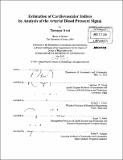Estimation of cardiovascular indices by analysis of the arterial blood pressure signal
Author(s)
Arai, Tatsuya
DownloadFull printable version (11.12Mb)
Other Contributors
Massachusetts Institute of Technology. Dept. of Aeronautics and Astronautics.
Advisor
Richard J. Cohen.
Terms of use
Metadata
Show full item recordAbstract
This thesis introduces novel mathematical algorithms that track changes in stroke volume (SV), cardiac output (CO), and total peripheral resistance (TPR) by analysis of the arterial blood pressure (ABP) signal. The algorithms incorporate cardiovascular physiology within the framework of a generalized Windkessel model, which is a widely accepted cardiovascular model. Algorithms to identify end systole were also developed and implemented in the new and existing SV, CO, and TPR estimation algorithms. The algorithms were validated by applying them to previously recorded Yorkshire swine data sets that include directly measured aortic blood flow (ABF), SV, CO, as well as central and peripheral ABP. Among the algorithms using the end systole identification algorithms, Parabolic Method, Modified Herd's Method, Kouchoukos Correction Method, and Corrected Impedance Method achieved low root normalized mean squared errors (RNMSEs). This thesis also introduces and validates a novel algorithm to reconstruct instantaneous ABF waveforms from the ABP signal. The algorithm utilizes an auto-regressive with exogenous input (ARX) model to describe the filter between ABF and ABP. Because ABF (the exogenous input to the peripheral circulation) is approximately zero during diastole, the diastolic ABP waveforms can be regarded as auto-regressive (AR). By the AR analysis of multiple diastolic ABP waveforms, the AR parameters are obtained. The AR parameters were applied to the ABP waveforms (both systolic and diastolic) to compute beat-to-beat ABF waveforms. The errors of skewness and kurtosis of the estimated ABF waveforms were statistically smaller than those estimated by the standard Windkessel model. The estimated ABF waveforms were further processed to estimate SV, CO, and TPR. The algorithm achieved RNMSEs of 15.3, 19.6, and 21.8% in SV estimation; 12.7, 15.2, and 15.8% in CO estimation; and 14.3, 20.9, and 19.4 % in TPR estimation derived from central, femoral, and radial ABP, respectively.
Description
Thesis (Ph. D.)--Massachusetts Institute of Technology, Dept. of Aeronautics and Astronautics, 2011. Cataloged from PDF version of thesis. Includes bibliographical references (p. 175-177).
Date issued
2011Department
Massachusetts Institute of Technology. Department of Aeronautics and AstronauticsPublisher
Massachusetts Institute of Technology
Keywords
Aeronautics and Astronautics.